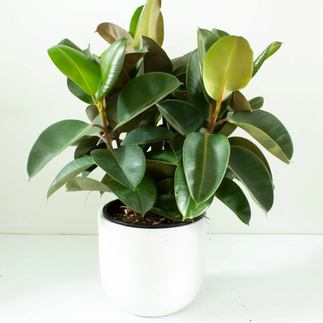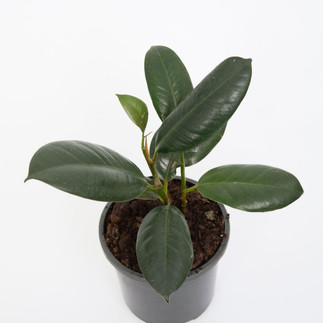Care Guide: Ficus Elastica
- Harleigh Reimer
- Aug 13, 2024
- 6 min read
Rubber plants are forgiving and easy to grow if you give them the right amount of light and a little neglect. Their glossy leaves sprout from sturdy brown stems, and in the wild, the rubber tree will grow to heights of 100 to 130 feet, and can live up to 100 years! Its most famous feature is the milky white sap that is sticky and 'rubbery', which flows from broken stems or leaves.
Overview of Rubber Plant Care
Botanical Name: Ficus elastica
Light: Very bright indirect light; can tolerate direct sunlight but only if it is gradually sun-hardened.
Watering: Allow the soil to dry out between waterings; and give it one big drink rather than lots of little bits here and there. Use well-draining, aerated soil.
Temperature: Prefers higher than 20 degrees; avoid drastic temperature changes and drafts to prevent leaf drop.
Humidity: Tolerates normal household humidity levels but appreciates extra humidity.
Size: Can grow as big as your pot allows - but don't go too big too fast or it will become stressed
Pruning: Encourages bushiness; new growth sprouts below the cut point.
Leaf Cleaning: Wipe with a microfibre cloth or shower the plant to keep the leaves glossy.
Propagation: Through stem cuttings.
Origin of the "Ficus Elastica" or Rubber Fig
The rubber plant, part of the Moraceae family, is native to eastern parts of South and Southeast Asia, from Nepal to Indonesia, Bhutan, Northeastern India, Myanmar, Yunnan in China, and Malaysia. It also grows in tropical regions worldwide, including here in Australia, Hawaii and the West Indies, and mild European Mediterranean areas. They can become invasive to local species, so be sure to keep it in a pot and not planted in the yard!
Did you know, in India, people guide the roots of large rubber trees over chasms to form living bridges? Amazing!
Most Common Varieties
There are quite a few varieties of Ficus Elastica, so let’s deep dive into some of the most popular:
Ficus elastica 'Robusta'
The 'Robusta' variety is the most common rubber plant, known for its glossy leaves that are deep green in colour.
Ficus elastica 'Burgundy'
This variety is prized for its dark, almost black, burgundy-coloured leaves. The deep colour adds a striking contrast to indoor spaces.
Ficus elastica 'Tineke'
'Tineke' features variegated leaves with a mix of green, cream, and pink tones. The variegation can look incredible matched with cream furniture and tones in your home!
Ficus elastica 'Ruby'
The 'Ruby' variety is similar to 'Tineke' but with more pronounced pink, red and orange hues in the leaves. The darkness and depth of the colours can vary depending on the light it receives
Ficus elastica 'Lemon Lime'
This variety features pale green leaves with splashes of cream and yellow. The unique coloration makes it a sought-after plant among collectors.
Ficus elastica 'Abidjan'
'Abidjan' is known for its deep burgundy leaves, which are even darker than the 'Burgundy' variety.
This is not an exhaustive list! There. are plenty more varieties to discover!
Light Requirements for your Rubber Fig
They will be happiest in the most bright spot in your home, filled with plenty of indirect light. They can tolerate some direct sunlight, but as they are mostly grown in shade houses, too much direct sun can burn the leaves. They can be sun-hardened, but you will need to acclimate the plant to direct light gradually. If not enough light is provided, the plant may become leggy with paler leaves or drop many (or even all!) of its leaves.
Placement in the Home
Rubber plants can be very temperamental about placement, so it's important you listen to them! If they are not happy, they will tell you by dropping leaves. If you are watering correctly, try moving them to a new location in your home and see if they like it better there.
Watering Requirements for your Rubber Fig
Rubber plants don’t need frequent watering. Allow the soil to dry out completely between waterings.
As they are used to periods of drought, the best way to water your fig is to drench the plant thoroughly, allowing excess water to drain from the pot. My favourite method is hosing down the leaves in the shower or on the patio - this mimics a rain shower and will also clean off dust from the leaves!
Signs of Overwatering
Overwatered rubber plants may have yellow leaves that fall off, soft stems, and brown or black patches indicating fungal or bacterial presence. To prevent overwatering, always leave the soil to dry completely before you water, and wait until the leaves start to droop down slightly. How do you know if the soil is dry? Simply pop your finger into the soil and feel!

Ideal Humidity & Temperature for your Rubber Plant
Rubber plants thrive at 20°C or above however they will tolerate periods of cold weather down to around 10°C if the change is gradual. Maintaining consistent temperatures to prevent shock and leaf drop.
Rubber plants enjoy extra humidity. Misting can help but is temporary. A humidifier or grouping with other plants can be more effective. Monitor for spider mites in drier, stagnant indoor air.
Pests to watch for
Due to the glossy leaves, rubber plants are more prone to scale than other plants. Other common pests include aphids, mealybugs, and spider mites.
Check and treat with a good quality pest-spray - if you notice multiple leaves yellowing, chances are you have an infestation. Our Mineral Oil is fantastic for eradicating an infestation, plus is doubles as a leaf shine to keep your plants clean and looking amazing.
Cleaning Leaves
It's important to clean the leaves of your rubber plant to help it photosynthesise - it also will make your plant look much more glossy and beautiful! This can be done by showering the plant or using our Mineral Oil and a microfibre cloth - this works for both a shine and pest prevention.
Signs of an unhappy rubber plant
As mentioned previously, the main signs of an unhappy rubber plant is yellow and browning leaves, then eventually leaf loss. If you notice your plant loosing multiple leaves, it's time to troubleshoot! Ensure you're following the tips in this post, (watering only when the soil is dry, keeping the plant in a very bright spot, checking for pests etc).
If your rubber plant has dropped all of its leaves from stress, chopping the trunk is a great solution to encourage new growth at lower points. Leaves often won't grow back at the lower parts of the trunk, instead it will prioritise new growth at the top. If you chop the stem at a lower part, the plant will fork into two and start growing fresh leaves from this point!

Repotting & Soil for your Rubber Plant
Rubber plants prefer well-draining, aerated soil, such as a mix with perlite and orchid bark, and you must have it in a pot with a good amount of drainage holes. Always check that water isn't pooling and sitting for for too long inside your decorative pot and soaking the plant!
Pot Size
Use a pot only about an inch larger than the root ball. Repot yearly if the plant is growing well, ideally in spring or summer.
Growth Potential
Indoors in pots, rubber plants can happily reach 3 meters or more, it really depends on how much ceiling height you have and the size of the pot. Outside, planted into the ground, they grow into ginormous trees - as previously mentioned they are also considered an invasive species in Australia so make sure you keep yours contained in a pot! As they grow, adding support like bamboo stakes or arches, can help keep their growth upright.
Fertiliser and Propagation
Regularly trim dead or yellowed growth to keep your plant healthy. If you want to propagate, this is best to be done by dividing the plant during repotting in the spring. Separate the roots and repot the divided plants, caring for them as usual until new growth appears. Fertilise monthly during the growing season (Spring & Summer) with a good liquid fertiliser - such as our Plant Coffee! Simply add a few drops in your watering can when you water - your plants will thank you for it!
Propagating Stem Cuttings
While not impossible, stem cuttings is a more difficult way to propagate your rubber plant. This can be done by taking a fresh stem cutting and placing in soil, water, or LECA. Use rooting hormone or honey for soil propagation, refresh water regularly for water propagation, and maintain LECA moisture levels for LECA propagation.
Pruning
Pruning promotes healthy growth, bushiness, and sturdier stems. New growth sprouts below the cut point, usually forking into two new stems, creating a fuller appearance. Prune strategically and be patient! This does take time.
Toxicity
Rubber plants have a white milky sap that is toxic if ingested. Keep this plant far away from any curious pets or children.
Want one?
Want to know more?
Keen to learn more about your houseplants? Come along to our next Indoor Plants 101 workshop for a crash course in everything you need to know about keeping your plants happy and healthy.
None in the calendar? Sign up here be the first to know about upcoming workshops.




















































Comments